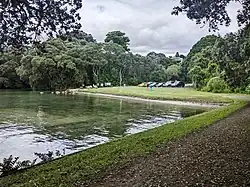Tanners Point
Tanners Point is a rural settlement in the Western Bay of Plenty District and Bay of Plenty Region of New Zealand's North Island. It is on a headland on the eastern side of Tauranga Harbour, opposite Katikati Entrance.[3]
Tanners Point | |
|---|---|
Rural settlement | |
 Tanners Point Recreational Reserve | |
| Coordinates: 37.482°S 175.944°E | |
| Country | New Zealand |
| Region | Bay of Plenty |
| Territorial authority | Western Bay of Plenty District |
| Ward | Katikati-Waihi Beach Ward |
| Community | Katikati Community |
| Electorates | |
| Government | |
| • Territorial Authority | Western Bay of Plenty District Council |
| • Regional council | Bay of Plenty Regional Council |
| Area | |
| • Total | 0.45 km2 (0.17 sq mi) |
| Population (June 2023)[2] | |
| • Total | 220 |
| • Density | 490/km2 (1,300/sq mi) |
| Postcode(s) | 3177 |
A reserve and walkway preserve the coastal areas of the settlement.[4]
The area, initially a Native reserve, was first called Frazer's Point and later Tanner's Point for local farmer Thomas Tanner who arrived in New Zealand in 1875.[5] Both names were in use in the early 20th century.[6][7]
Demographics
Tanners Point is defined by Statistics New Zealand as a rural settlement and covers 0.45 km2 (0.17 sq mi)[1] and had an estimated population of 220 as of June 2023,[2] with a population density of 489 people per km2. It is part of the larger Tahawai statistical area.[8]
| Year | Pop. | ±% p.a. |
|---|---|---|
| 2006 | 216 | — |
| 2013 | 171 | −3.28% |
| 2018 | 201 | +3.29% |
| Source: [9] | ||
Tanners Point had a population of 201 at the 2018 New Zealand census, an increase of 30 people (17.5%) since the 2013 census, and a decrease of 15 people (−6.9%) since the 2006 census. There were 93 households, comprising 105 males and 96 females, giving a sex ratio of 1.09 males per female. The median age was 62.7 years (compared with 37.4 years nationally), with 12 people (6.0%) aged under 15 years, 12 (6.0%) aged 15 to 29, 90 (44.8%) aged 30 to 64, and 87 (43.3%) aged 65 or older.
Ethnicities were 94.0% European/Pākehā, 4.5% Māori, 1.5% Pacific peoples, and 3.0% Asian. People may identify with more than one ethnicity.
Although some people chose not to answer the census's question about religious affiliation, 49.3% had no religion, 34.3% were Christian, 1.5% were Hindu, 1.5% were Buddhist and 4.5% had other religions.
Of those at least 15 years old, 42 (22.2%) people had a bachelor's or higher degree, and 30 (15.9%) people had no formal qualifications. The median income was $31,600, compared with $31,800 nationally. 36 people (19.0%) earned over $70,000 compared to 17.2% nationally. The employment status of those at least 15 was that 60 (31.7%) people were employed full-time, 24 (12.7%) were part-time, and 6 (3.2%) were unemployed.[9]
References
- "ArcGIS Web Application". statsnz.maps.arcgis.com. Retrieved 24 November 2022.
- "Subnational population estimates (RC, SA2), by age and sex, at 30 June 1996-2023 (2023 boundaries)". Statistics New Zealand. Retrieved 25 October 2023. (regional councils); "Subnational population estimates (TA, SA2), by age and sex, at 30 June 1996-2023 (2023 boundaries)". Statistics New Zealand. Retrieved 25 October 2023. (territorial authorities); "Subnational population estimates (urban rural), by age and sex, at 30 June 1996-2023 (2023 boundaries)". Statistics New Zealand. Retrieved 25 October 2023. (urban areas)
- Harriss, Gavin (August 2022). Tanners Point, Bay of Plenty (Map). NZ Topo Map.
- "Tanners Point". Western Bay of Plenty District Council. Retrieved 27 November 2020.
- Rorke, Jinty (27 March 1995). "Western Bay of Plenty Street Names – Katikati – Farming Families". Bay of Plenty Times.
- "Personal Notes". Bay of Plenty Times. 25 May 1908.
- "Tauranga Harbour – Proposal for Reclamation". The New Zealand Herald. 17 August 1932.
- 2018 Census place summary: Tahawai
- "Statistical area 1 dataset for 2018 Census". Statistics New Zealand. March 2020. 7013525.